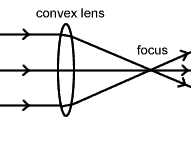
3A 16/03/05
We did a short practical which used lenses. A convex lens converges parallel rays of light to a point. This is called the focal point of the lens, and the distance between the centre of the lens and the focal point is called the focal length.

A concave lens diverges (spreads out) parallel rays. It has a focal point which is imaginary, made by continuing the spreading out rays onwards. Diverging lenses have a negative focal length.
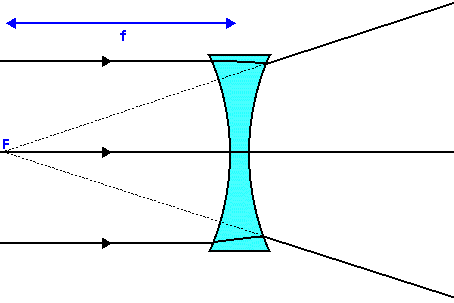
3C 16/03/05
Aha. You were all absent for some drama festival or something. Therefore, the light test will be held first lesson of next term. If you have the temerity to complain about this, I will dock your mark by 5%.
3A 14/03/05
Total internal reflection (as seen in the semi circular glass block experiment) can be used to carry light down transparent cables, called optical fibres.

Light enters the cable at one end and leaves at the other. Every time it hits the internal surface of the cable, it strikes at greater than the critical angle. Therefore total internal reflection occurs and it passes on through the cable.
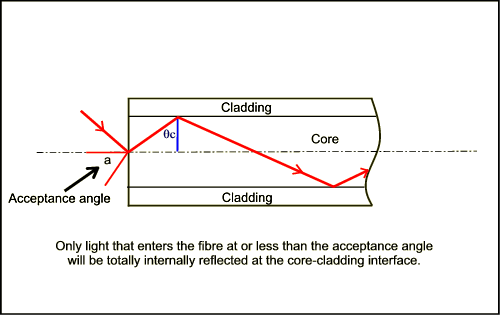
We saw a video on optical fibres. Light entering the cable at one end is totally internally reflected all the way to the other end, as long as it doesn't strike the internal suface at less than the critical angle.
Advantages of optical fibres over electrical wires are:
There are a couple of disadvantages: It is hard to join (splice) optical fibres together accurately. Also, the very careful manufacturing process required for optical fibres means they need high technology and expensive factories to make them.
HW Essay "How optical fibres have helped us to send much more information around the world in the past 25 years". Include how optical fibres work, how they have improved communications, and advantages over electrical signalling.
3C 09/03/05
RM absent (CCF). You did a past light test and some more work on refraction, colour and then lenses.
3C 08/03/05
We talked about image forming. An image of an object can only form when all the light shining from the object reaches the image at exactly the same point. A pinhole camera achieves this easily by only letting light shine through a very small hole. Lenses can be used which bend all light from a particular point on the object to reach exactly the same point at the image.
3A 07/03/05
We did an apparent depth practical. By lining up pins, we could work out the apparent position of a pin when viewed through a perspex block. This meant intersecting 2 different rays.
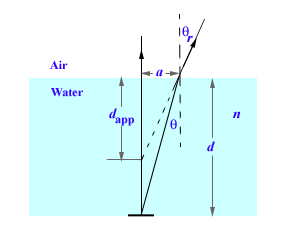
The refractive index of a transparent material can be found by dividing the actual depth by the apparent depth of an object viewed through it.
The refractive index is a measure of how much light is slowed down by the material.
Speed of light in a material = Speed of light in a vacuum / Refractive index
Light comes in different colours. The primary colours are red, green and blue. Mix all three together and we see white.
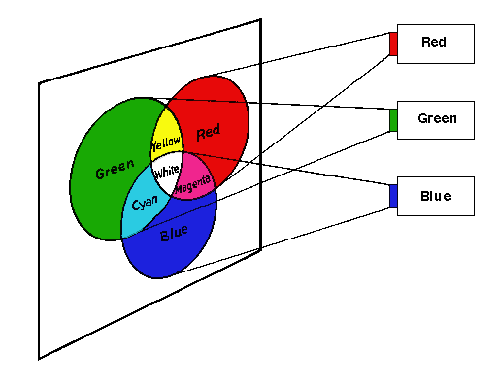
However, white light from the Sun comes with all of the the colours of the rainbow present (RedOrangeYellowGreenBlueIndigoViolet). Light can be split into its constituent parts by using a prism.

3A 02/03/05
Nobody was here! I exaggerate, but we kept the next topic on hold for a bit and watched some videos on the refraction of light.
Penny in the beaker sheet will be taken in next time.
3C 02/03/05
We attempted some problems covering most of the light topic. People are still struggling with Snell's law, perhaps understandably. It is fairly tricky for you to deal with at present.
We did a short practical which used lenses. A convex lens converges parallel rays of light to a point. This is called the focal point of the lens, and the distance between the centre of the lens and the focal point is called the focal length.

A concave lens diverges (spreads out) parallel rays. It has a focal point which is imaginary, made by continuing the spreading out rays onwards. Diverging lenses have a negative focal length.

HW Find out what is wrong with people who have both short sight and long sight. Either explain, or find ray diagrams to show the problem.
3C 01/03/05
We solved a variety of problems which involved shining light rays into various prisms. TIR and refraction were both employed.
3A 28/02/05
We did an experiment to see how the angle of a ray of light changed as it exited a glass block.
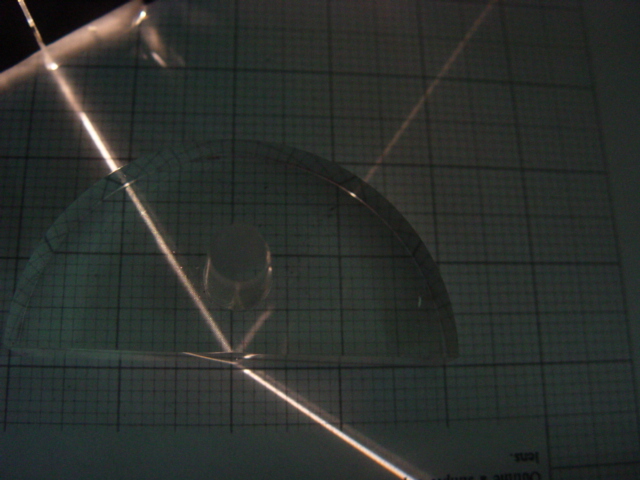
The ray doesn't bend on the way in, it is at 90 degrees to the glass surface. It turns away from the normal on the way out, as it speeds up. It obeys Snell's law in this case.

As the angle increases, the ray is refracted nearer to the glass surface and is split into a coloured spectrum and a weak reflected ray appears.

Above a certain angle, the critical angle (about 42 degrees for glass) all of the ray is reflected back. This is called total internal reflection
HW Fill in the sheet showing the light rays for the penny in a beaker experiment seen last time.
3A 23/02/05
We went through the kinetic theory test.
Some coins had been stuck into the bottom of some metal beakers. The coins, which were slightly out of view, became visible when the metal beakers were filled with water. This could not be explained by light travelling in straight lines. The light that reflected from the coin was bent somehow when it moved from the water back out into the air. This allowed us to see "around the corner".
This phenomenon is known as refraction. It occurs because light travels at a slower speed in transparent mediums (materials that it can pass through)than it does in air/a vacuum.
This is why anything that you look at underwater will appear shallower than it actually is.
AG and TB are in on Monday lunchtime sanding.
3C 23/02/05
We saw a video on optical fibres. Light entering the cable at one end is totally internally reflected all the way to the other end, as long as it doesn't strike the internal suface at less than the critical angle.
Advantages of optical fibres over electrical wires are:
There are a couple of disadvantages: It is hard to join (splice) optical fibres together accurately. Also, the very careful manufacturing process required for optical fibres means they need high technology and expensive factories to make them.
HW Essay "How optical fibres have helped us to send much more information around the world in the past 25 years". Include how optical fibres work, how they have improved communications, and advantages over electrical signalling.
3C 22/02/05
We looked at Snell's law one last time, making sure we knew what all the terms meant. Then a video summarising all we had done in light so far.
Total internal reflection (as seen in the semi circular glass block experiment) can be used to carry light down transparent cables, called optical fibres.

Light enters the cable at one end and leaves at the other. Every time it hits the internal surface of the cable, it strikes at greater than the critical angle. Therefore total internal reflection occurs and it passes on through the cable.

More on these tomorrow.
3A 21/02/05
We did a practical to start off a new topic - light. Rays were found to always bend towards the normal line (90 degrees from the glass surface) when they entered the block.

There was a mathematical relationship between the angle of incidence (angle between ray on the way in and the normal) and the angle of refraction (angle between the ray inside the block that has changed direction and the normal)
This used the function sin . sin i was proportional to sin r . You will learn about sin in maths.
sin i / sin r (the gradient of the graph you plotted) gave us an idea of how much perspex bent light. This is a property of the perspex known as its refractive index, n. Our answer was about 1.4. This means that light travels 1.4 times slower in perspex than it does in air. (air hardly slows down light at all - it has a refractive index of very slightly over 1)
3A 09/02/05
We sat the kinetic theory test, except for PC, who had a nosebleed and absentees.
3C 09/02/05
We did an experiment to see how the angle of a ray of light changed as it exited a glass block.

The ray doesn't bend on the way in, it is at 90 degrees to the glass surface. It turns away from the normal on the way out, as it speeds up. It obeys Snell's law in this case.

As the angle increases, the ray is refracted nearer to the glass surface and is split into a coloured spectrum and a weak reflected ray appears.

Above a certain angle, the critical angle (about 42 degrees for glass) all of the ray is reflected back. This is called total internal reflection
HW Finish Qs 1-9 from page 89-91 from Spectrum Physics. Also finish the graph and questions from this experiment if you haven't yet done so. Have a nice half term>
3C 08/02/05
We did an apparent depth practical. By lining up pins, we could work out the apparent position of a pin when viewed through a perspex block.

The refractive index of a transparent material can be found by dividing the actual depth by the apparent depth of an object viewed through it.
The refractive index is a measure of how much light is slowed down by the material.
3A 07/02/05
RM absent. You completed pressure quesions from page 150-154 of Spectrum Phys.
3A 02/02/05
We revised the idea of pressure. Pressure = Force/area.
Machines use a system called hydraulics to gain a mechanical advantage (to exert bigger forces than they would otherwise be able to.) This works because the pressure in a liquid is the same throughout the liquid (on a small scale). Connecting a piston with a small area to a piston with a large area with fluid means that the pressure will be the same at both ends. The force required to depress the small piston will be much smaller than the possible force at the large piston.
P = F/A P is the same at both ends, but A is bigger at the piston than the pump. Therefore, F must also be larger.
3C 02/02/05
An experiment was carried out to see how much rays of light bent when they passed into a glass or perspex block. Rays were found to always bend towards the normal line (90 degrees from the glass surface) when they entered the block.

There was a mathematical relationship between the angle of incidence (angle between ray on the way in and the normal) and the angle of refraction (angle between the ray inside the block that has changed direction and the normal)
This used the function sin . sin i was proportional to sin r . You will learn about sin in maths.
sin i / sin r (the gradient of the graph you plotted) gave us an idea of how much perspex bent light. This is a property of the perspex known as its refractive index, n. Our answer was about 1.4. This means that light travels 1.4 times slower in perspex than it does in air. (air hardly slows down light at all - it has a refractive index of very slightly over 1)
HW Complete the practical sheet - graph must be plotted with a straight line of best fit and all questions answered to hand in next time.
3C 01/02/05
Some coins had been stuck into the bottom of some metal beakers. The coins, which were slightly out of view, became visible when the metal beakers were filled with water. This could not be explained by light travelling in straight lines. The light that reflected from the coin was bent somehow when it moved from the water back out into the air. This allowed us to see "around the corner".
This phenomenon is known as refraction. It occurs because light travels at a slower speed in transparent mediums (materials that it can pass through)than it does in air/a vacuum.
AR, RS and JC owe essays for tomorrow!
3A 31/01/05
An experiment to test how the pressure of a gas varied as you change its volume was carried out. The temperature of the gas was kept constant (as we know that this would change the pressure). Giving the same number of gas particles a smaller space to whizz around in means that they will hit the walls more often, exerting more force. e.g. Smaller volume implies a higher pressure. In fact, pressure is inversely proportional to the volume that a gas occupies. Double the volume of a gas, and you will halve its pressure. The pressure, volume and temperature of a gas are all related. PV/T is a constant.
HW None - books in. There will be a kinetic theory (everything since Brownian motion) test next Monday. AG owes me 2 essays!
3C 26/01/05
We went through the kinetic theory test.
Then onto light as a new topic. Light comes in different colours. The primary colours are red, green and blue. Mix all three together and we see white.

However, white light from the Sun comes with all of the the colours of the rainbow present (RedOrangeYellowGreenBlueIndigoViolet). Light can be split into its constituent parts by using a prism.

HW P92 Qs 1,2,4,6 Spectrum Phys.
AR and RS owe me essays!
3C 25/01/05
Test on kinetic theory happened. Next time - light. BN and HP owe me essays.
3A 24/01/05
We did an experiment to see how the temperature of a fixed volume of gas changed the pressure which it exerted. All gases exert a pressure on objects they come into contact with as the particles of the gas consistently bounce off the objects putting a force on it.
HW Finish the graph of results and then do the 2 write up sections of the sheet.
3A 19/01/05
Pressure was revised. Pressure = Force/Area. Gases and liquids exert pressure because of the collisions that the individual particles have with solids that are touching them. PJ, AG, AR and TB owe me an essay.
3C 19/01/05
An experiment to test how the pressure of a gas varied as you change its volume was carried out. The temperature of the gas was kept constant (as we know that this would change the pressure). Giving the same number of gas particles a smaller space to whizz around in means that they will hit the walls more often, exerting more force. e.g. Smaller volume implies a higher pressure. In fact, pressure is inversely proportional to the volume that a gas occupies. The pressure, volume and temperature of a gas are all related. PV/T is a constant.
HW Revise for a test on all kinetic theory stuff. Things done since start of term.
3C 18/01/05
We revised the idea of pressure. Pressure = Force/area.
Machines use a system called hydraulics to gain a mechanical advantage (to exert bigger forces than they would otherwise be able to.) This works because the pressure in a liquid is the same throughout the liquid (on a small scale). Connecting a piston with a small area to a piston with a large area with fluid means that the pressure will be the same at both ends. The required to depress the small piston will be much smaller than the possible force at the large piston.
3A 12/01/05
Kinetic theory - reducing the actions of materials down to the motion of the individual particles.
But how do we know that materials are made up of individual atoms? We saw some evidence for this. Looking at illuminated smoke particles (very small lumps of carbon) through a microscope, we saw them jiggling around at random. This motion cannot be explained unless the particles are being hit by individual gas molecules from around them, knocking them this way and that.
It is called Brownian motion, first spotted by a biologist looking at pollen grains suspended in water.
HW To finish answering all of the questions on Brownian motion from the powerpoint file. The questions were as follows:
We did an experiment to see how the temperature of a fixed volume of gas changed the pressure which it exerted. All gases exert a pressure on objects they come into contact with as the particles of the gas consistently bounce off the objects putting a force on it.
HW Finish the graph of results and then do the 2 write up sections of the sheet. (Brownian motion Qs must also be finished)
3C 11/01/05
Kinetic theory - reducing the actions of materials down to the motion of the individual particles.
But how do we know that materials are made up of individual atoms? We saw some evidence for this. Looking at illuminated smoke particles (very small lumps of carbon) through a microscope, we saw them jiggling around at random. This motion cannot be explained unless the particles are being hit by individual gas molecules from around them, knocking them this way and that.
It is called Brownian motion, first spotted by a biologist looking at pollen grains suspended in water.